air suspension BMW X5 2005 E53 Level Control System Manual
[x] Cancel search | Manufacturer: BMW, Model Year: 2005, Model line: X5, Model: BMW X5 2005 E53Pages: 57, PDF Size: 1.89 MB
Page 31 of 57
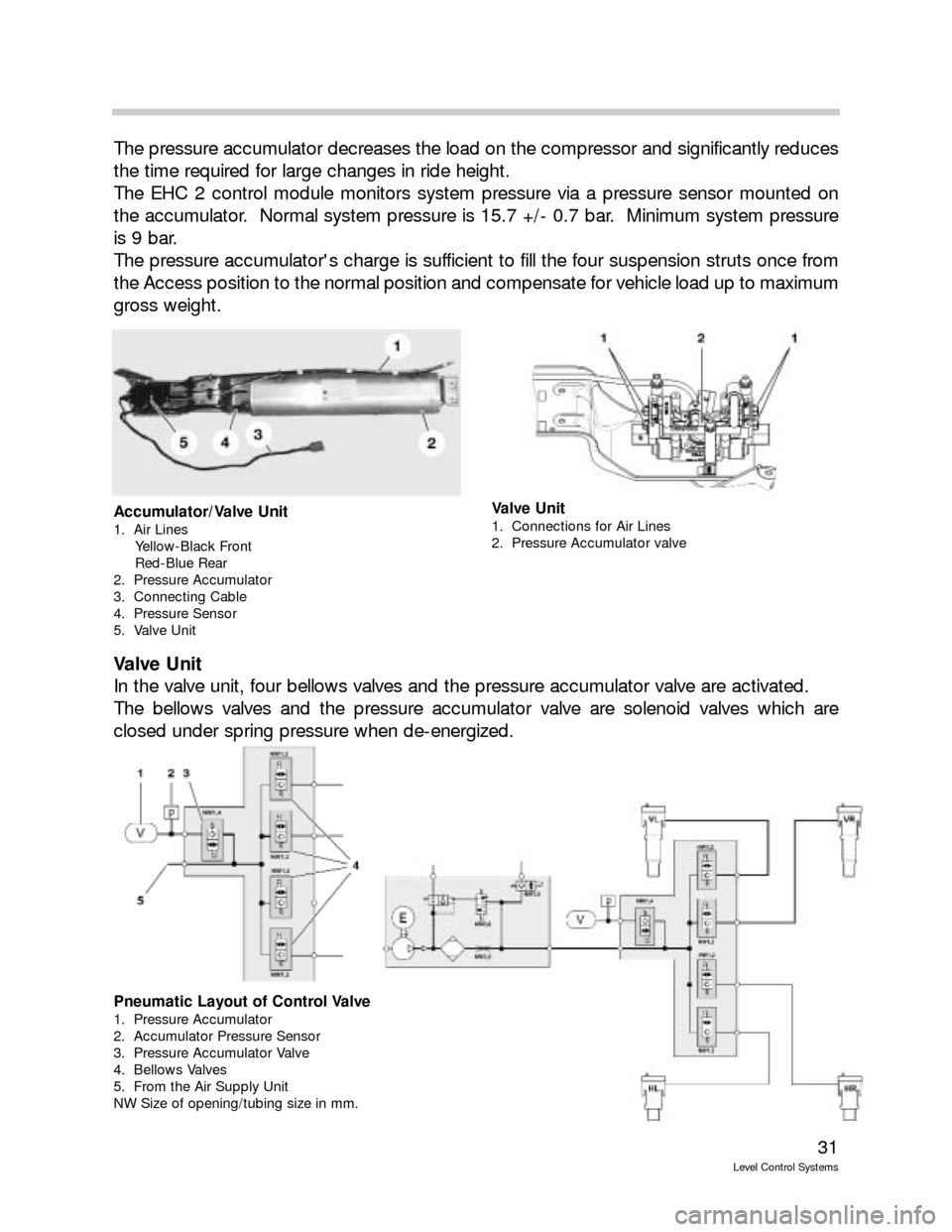
31
Level Control Systems
The pressure accumulator decreases the load on the compressor and significantly reduces
the time required for large changes in ride height.
The EHC 2 control module monitors system pressure via a pressure sensor mounted on
the accumulator. Normal system pressure is 15.7 +/- 0.7 bar. Minimum system pressure
is 9 bar.
The pressure accumulator's charge is sufficient to fill the four suspension struts once from
the Access position to the normal position and compensate for vehicle load up to maximum
gross weight.
Valve Unit
In the valve unit, four bellows valves and the pressure accumulator valve are activated.
The bellows valves and the pressure accumulator valve are solenoid valves which are
closed under spring pressure when de-energized.
Accumulator/Valve Unit
1. Air Lines
Yellow-Black Front
Red-Blue Rear
2. Pressure Accumulator
3. Connecting Cable
4. Pressure Sensor
5. Valve Unit
Valve Unit
1. Connections for Air Lines
2. Pressure Accumulator valve
Pneumatic Layout of Control Valve
1. Pressure Accumulator
2. Accumulator Pressure Sensor
3. Pressure Accumulator Valve
4. Bellows Valves
5. From the Air Supply Unit
NW Size of opening/tubing size in mm.
Page 33 of 57
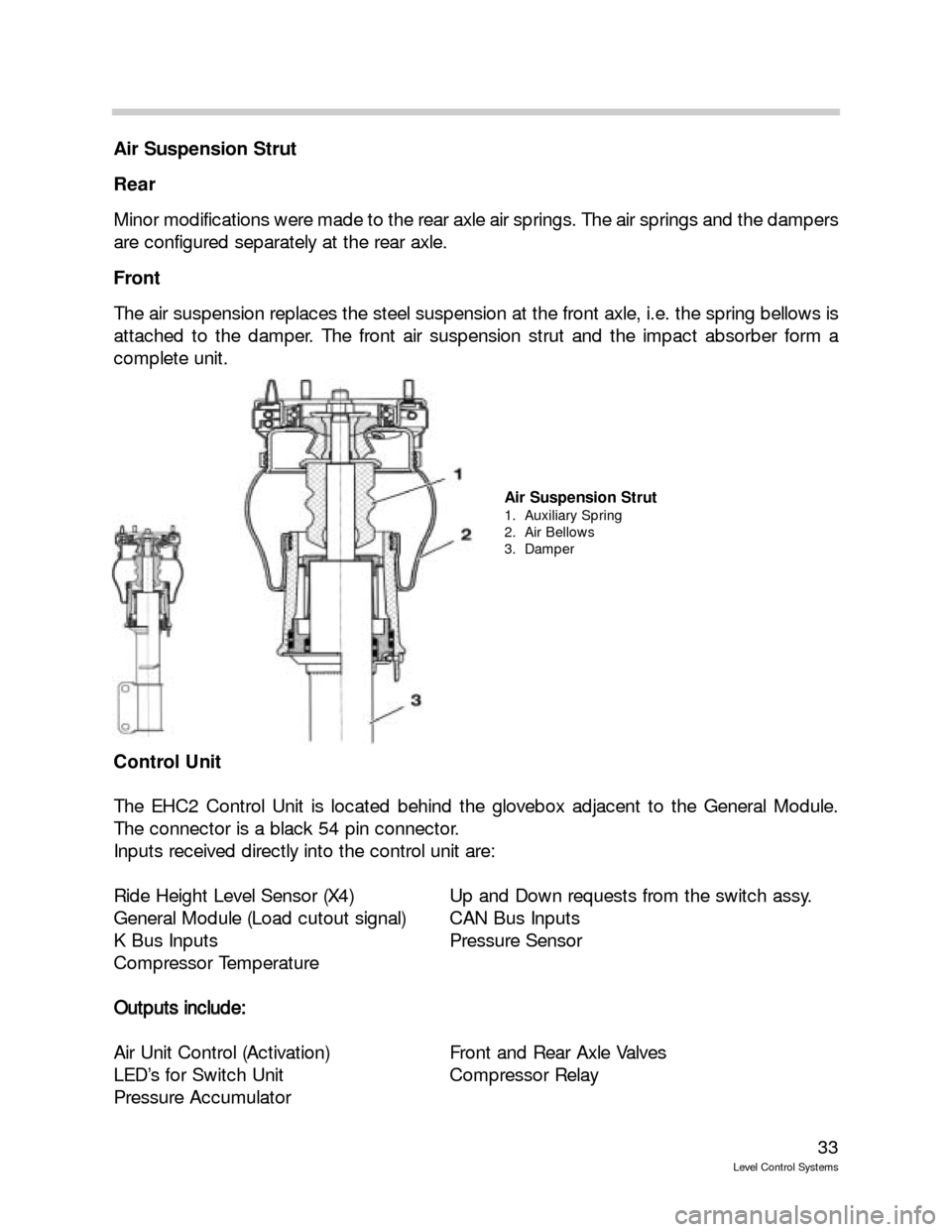
33
Level Control Systems
Air Suspension Strut
Rear
Minor modifications were made to the rear axle air springs. The air springs and the dampers
are configured separately at the rear axle.
Front
The air suspension replaces the steel suspension at the front axle, i.e. the spring bellows is
attached to the damper. The front air suspension strut and the impact absorber form a
complete unit.
Control Unit
The EHC2 Control Unit is located behind the glovebox adjacent to the General Module.
The connector is a black 54 pin connector.
Inputs received directly into the control unit are:
Ride Height Level Sensor (X4) Up and Down requests from the switch assy.
General Module (Load cutout signal) CAN Bus Inputs
K Bus Inputs Pressure Sensor
Compressor Temperature
O Ou
ut
tp
pu
ut
ts
s
i
in
nc
cl
lu
ud
de
e:
:
Air Unit Control (Activation) Front and Rear Axle Valves
LED’s for Switch Unit Compressor Relay
Pressure Accumulator
Air Suspension Strut
1. Auxiliary Spring
2. Air Bellows
3. Damper
Page 35 of 57

35
Level Control Systems
Principle of Operation
Ride Height Control Operations
In addition to the automatic ride-height control system for payload compensation, the dri-
ver can set three different vehicle ride heights.
Off-road (+25 mm), high ground clearance to a max. speed of 50 km/h
Standard (0 mm), normal ride level
Access (-35 mm), for entry and exit, loading and unloading to a max. speed of 35 km/h
or can be activated in Standard mode at road speeds < 25 km/h
The various heights are selected by scroll rocker. Light emitting diodes indicate the present
ride height setting.
Ride height can be adjusted from terminal 15 and with the doors closed. The hood and tail-
gate may be open.
The system also controls inclination automatically, like the single axle air suspension.
All control operations are executed without stopping at intermediate levels. The vehicle is
configured pneumatically in such a way that the front and rear axles can be lowered in par-
allel in any load situation. Depending on the load situation, either the front axle or the rear
axle is slightly quicker. On account of the different control speeds, a difference in height
between the two axles is possible during all control operations. If a max. permissible thresh-
old is exceeded, the quicker axle is stopped briefly.
The various levels can be preselected while travelling. Changeover between ride levels is
effected at the speed threshold values defined in the control unit. The control unit monitors
the change-over.
As soon as the driver sets a new target ride level by pressing a button or when a change-
over is initiated automatically by a specific driving condition, the LED for the current ride
level remains lit and the LED for the target ride level begins to flash.
When the new level is reached, the LED for the previous level goes out and the LED for the
new level reached stays lit permanently.
Page 37 of 57
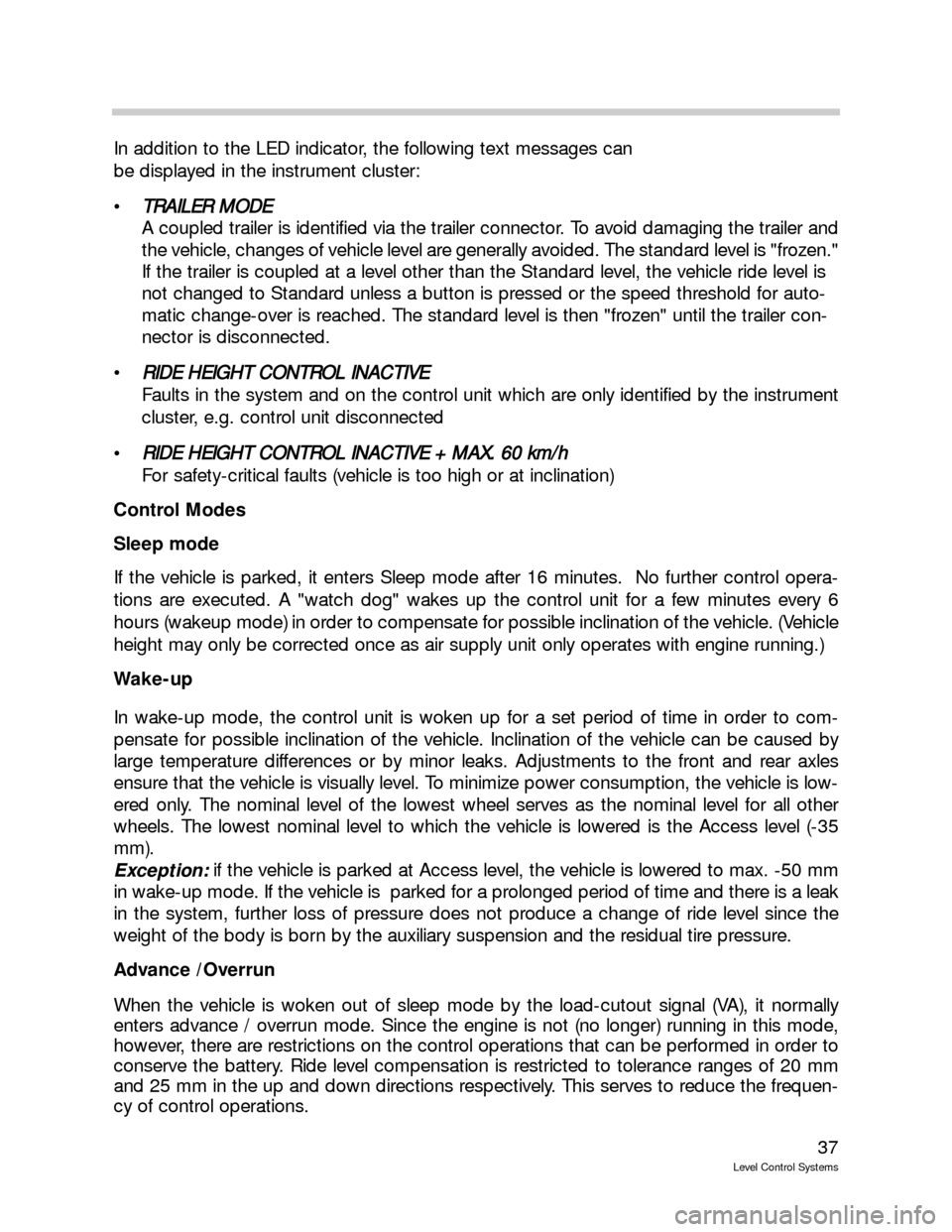
37
Level Control Systems
In addition to the LED indicator, the following text messages can
be displayed in the instrument cluster:
T TR
RA
AI
IL
LE
ER
R
M
MO
OD
DE
E
A coupled trailer is identified via the trailer connector. To avoid damaging the trailer and
the vehicle, changes of vehicle level are generally avoided. The standard level is "frozen."
If the trailer is coupled at a level other than the Standard level, the vehicle ride level is
not changed to Standard unless a button is pressed or the speed threshold for auto-
matic change-over is reached. The standard level is then "frozen" until the trailer con-
nector is disconnected.
R RI
ID
DE
E
H
HE
EI
IG
GH
HT
T
C
CO
ON
NT
TR
RO
OL
L
I
IN
NA
AC
CT
TI
IV
VE
E
Faults in the system and on the control unit which are only identified by the instrument
cluster, e.g. control unit disconnected
R RI
ID
DE
E
H
HE
EI
IG
GH
HT
T
C
CO
ON
NT
TR
RO
OL
L
I
IN
NA
AC
CT
TI
IV
VE
E
+
+
M
MA
AX
X.
.
6
60
0
k
km
m/
/h
h
For safety-critical faults (vehicle is too high or at inclination)
Control Modes
Sleep mode
If the vehicle is parked, it enters Sleep mode after 16 minutes. No further control opera-
tions are executed. A "watch dog" wakes up the control unit for a few minutes every 6
hours (wakeup mode) in order to compensate for possible inclination of the vehicle. (Vehicle
height may only be corrected once as air supply unit only operates with engine running.)
Wake-up
In wake-up mode, the control unit is woken up for a set period of time in order to com-
pensate for possible inclination of the vehicle. Inclination of the vehicle can be caused by
large temperature differences or by minor leaks. Adjustments to the front and rear axles
ensure that the vehicle is visually level. To minimize power consumption, the vehicle is low-
ered only. The nominal level of the lowest wheel serves as the nominal level for all other
wheels. The lowest nominal level to which the vehicle is lowered is the Access level (-35
mm).
Exception:if the vehicle is parked at Access level, the vehicle is lowered to max. -50 mm
in wake-up mode. If the vehicle is parked for a prolonged period of time and there is a leak
in the system, further loss of pressure does not produce a change of ride level since the
weight of the body is born by the auxiliary suspension and the residual tire pressure.
Advance /Overrun
When the vehicle is woken out of sleep mode by the load-cutout signal (VA), it normally
enters advance / overrun mode. Since the engine is not (no longer) running in this mode,
however, there are restrictions on the control operations that can be performed in order to
conserve the battery. Ride level compensation is restricted to tolerance ranges of 20 mm
and 25 mm in the up and down directions respectively. This serves to reduce the frequen-
cy of control operations.
Page 40 of 57
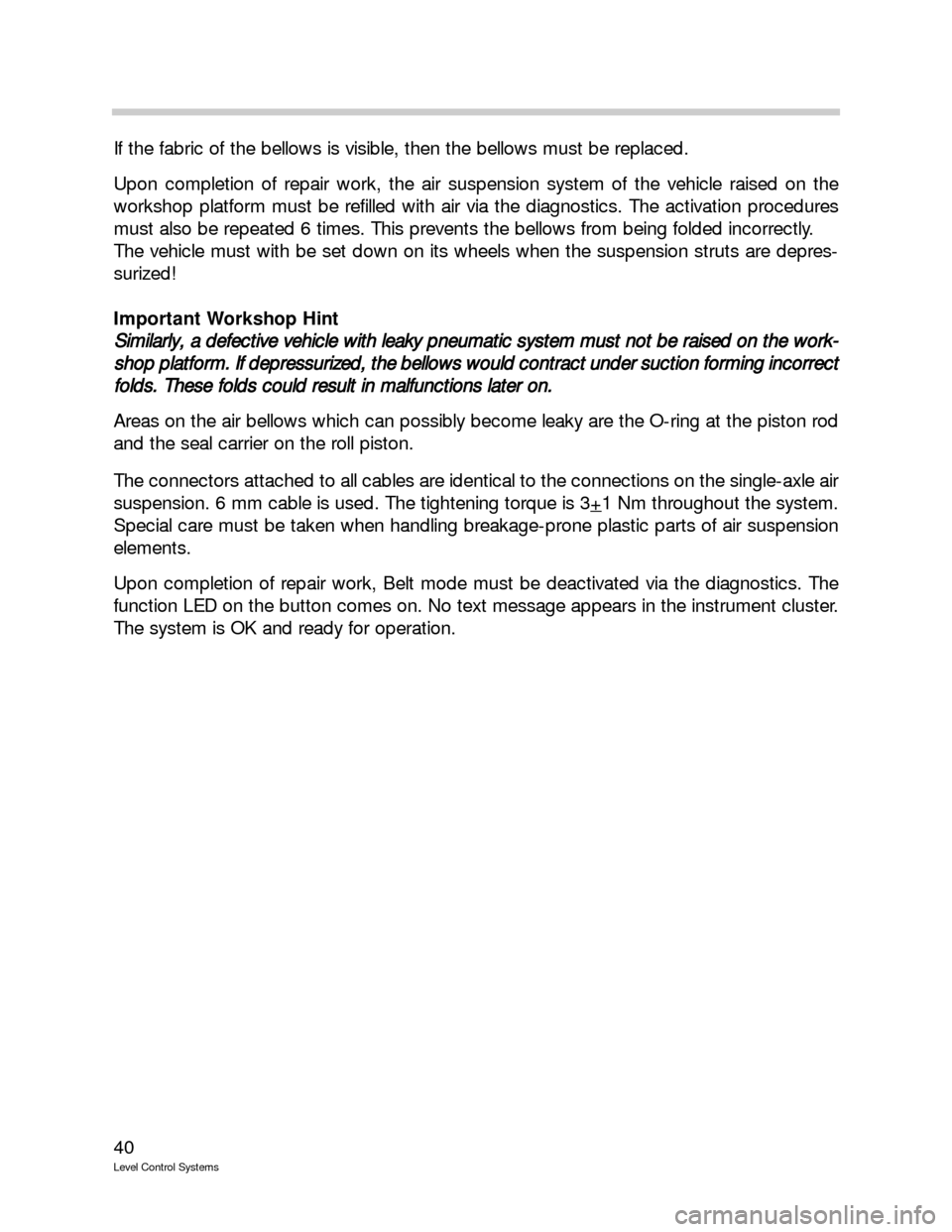
40
Level Control Systems
If the fabric of the bellows is visible, then the bellows must be replaced.
Upon completion of repair work, the air suspension system of the vehicle raised on the
workshop platform must be refilled with air via the diagnostics. The activation procedures
must also be repeated 6 times. This prevents the bellows from being folded incorrectly.
The vehicle must with be set down on its wheels when the suspension struts are depres-
surized!
Important Workshop Hint
S Si
im
mi
il
la
ar
rl
ly
y,
,
a
a
d
de
ef
fe
ec
ct
ti
iv
ve
e
v
ve
eh
hi
ic
cl
le
e
w
wi
it
th
h
l
le
ea
ak
ky
y
p
pn
ne
eu
um
ma
at
ti
ic
c
s
sy
ys
st
te
em
m
m
mu
us
st
t
n
no
ot
t
b
be
e
r
ra
ai
is
se
ed
d
o
on
n
t
th
he
e
w
wo
or
rk
k-
-
s sh
ho
op
p
p
pl
la
at
tf
fo
or
rm
m.
.
I
If
f
d
de
ep
pr
re
es
ss
su
ur
ri
iz
ze
ed
d,
,
t
th
he
e
b
be
el
ll
lo
ow
ws
s
w
wo
ou
ul
ld
d
c
co
on
nt
tr
ra
ac
ct
t
u
un
nd
de
er
r
s
su
uc
ct
ti
io
on
n
f
fo
or
rm
mi
in
ng
g
i
in
nc
co
or
rr
re
ec
ct
t
f fo
ol
ld
ds
s.
.
T
Th
he
es
se
e
f
fo
ol
ld
ds
s
c
co
ou
ul
ld
d
r
re
es
su
ul
lt
t
i
in
n
m
ma
al
lf
fu
un
nc
ct
ti
io
on
ns
s
l
la
at
te
er
r
o
on
n.
.
Areas on the air bellows which can possibly become leaky are the O-ring at the piston rod
and the seal carrier on the roll piston.
The connectors attached to all cables are identical to the connections on the single-axle air
suspension. 6 mm cable is used. The tightening torque is 3+
1 Nm throughout the system.
Special care must be taken when handling breakage-prone plastic parts of air suspension
elements.
Upon completion of repair work, Belt mode must be deactivated via the diagnostics. The
function LED on the button comes on. No text message appears in the instrument cluster.
The system is OK and ready for operation.
Page 41 of 57
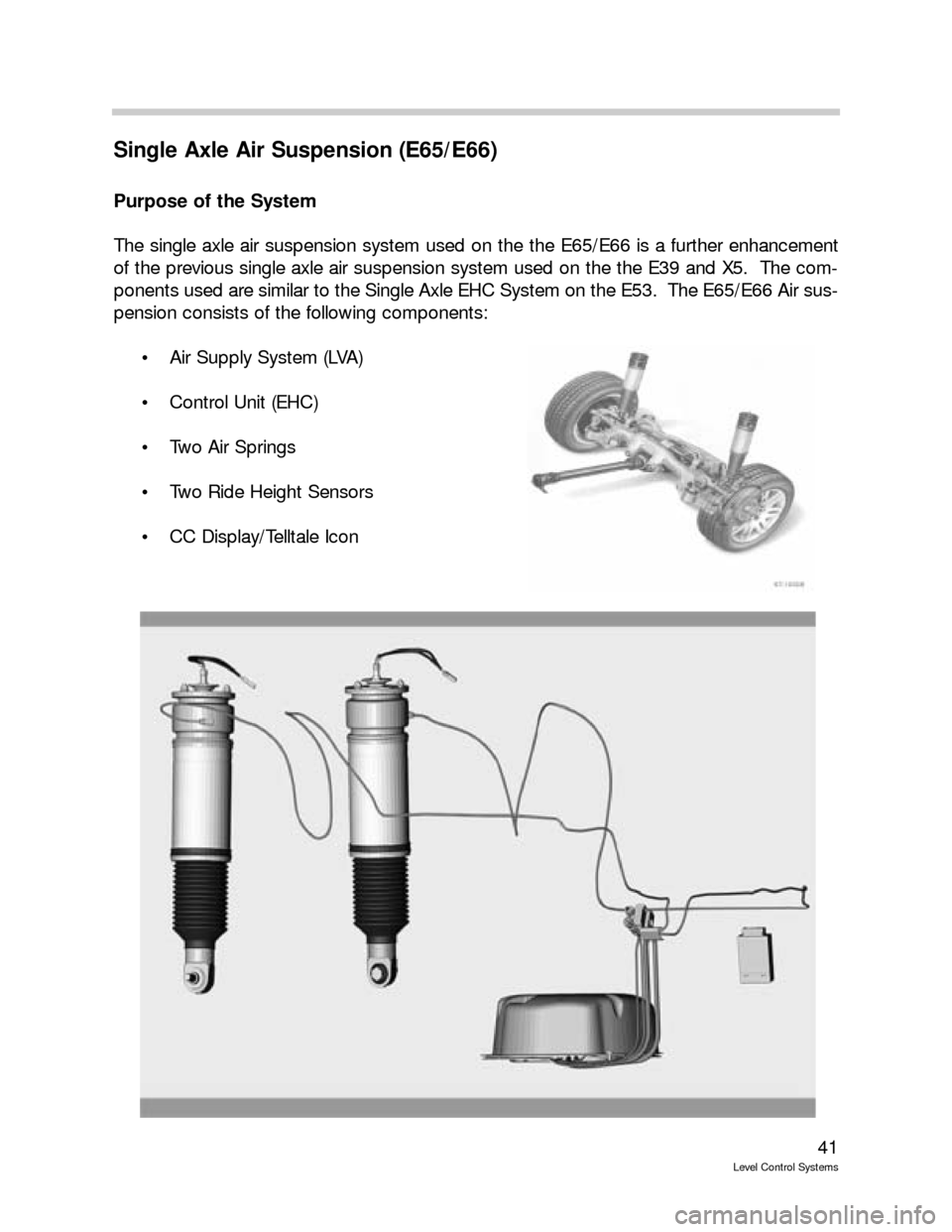
41
Level Control Systems
Single Axle Air Suspension (E65/E66)
Purpose of the System
The single axle air suspension system used on the the E65/E66 is a further enhancement
of the previous single axle air suspension system used on the the E39 and X5. The com-
ponents used are similar to the Single Axle EHC System on the E53. The E65/E66 Air sus-
pension consists of the following components:
Air Supply System (LVA)
Control Unit (EHC)
Two Air Springs
Two Ride Height Sensors
CC Display/Telltale Icon
Page 45 of 57
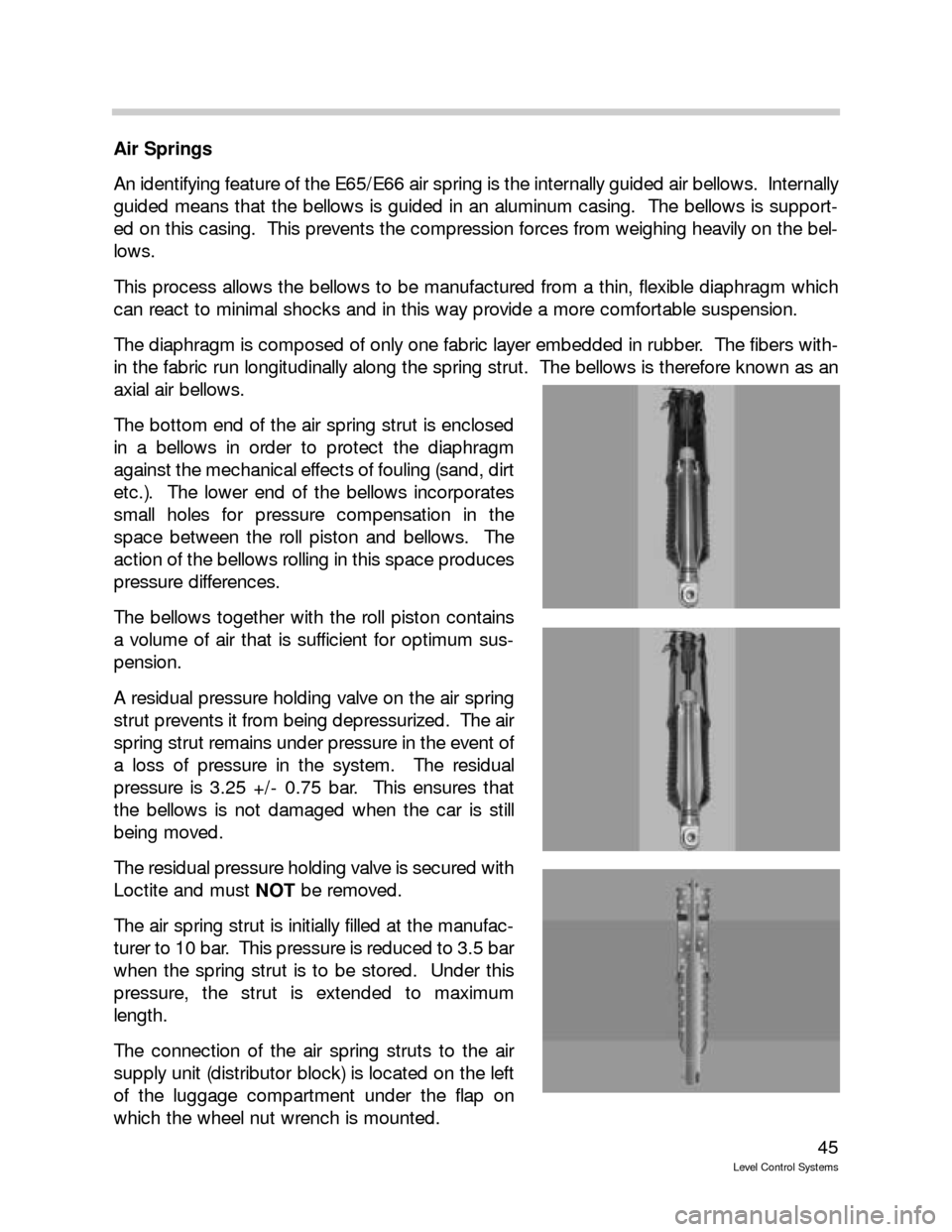
45
Level Control Systems
Air Springs
An identifying feature of the E65/E66 air spring is the internally guided air bellows. Internally
guided means that the bellows is guided in an aluminum casing. The bellows is support-
ed on this casing. This prevents the compression forces from weighing heavily on the bel-
lows.
This process allows the bellows to be manufactured from a thin, flexible diaphragm which
can react to minimal shocks and in this way provide a more comfortable suspension.
The diaphragm is composed of only one fabric layer embedded in rubber. The fibers with-
in the fabric run longitudinally along the spring strut. The bellows is therefore known as an
axial air bellows.
The bottom end of the air spring strut is enclosed
in a bellows in order to protect the diaphragm
against the mechanical effects of fouling (sand, dirt
etc.). The lower end of the bellows incorporates
small holes for pressure compensation in the
space between the roll piston and bellows. The
action of the bellows rolling in this space produces
pressure differences.
The bellows together with the roll piston contains
a volume of air that is sufficient for optimum sus-
pension.
A residual pressure holding valve on the air spring
strut prevents it from being depressurized. The air
spring strut remains under pressure in the event of
a loss of pressure in the system. The residual
pressure is 3.25 +/- 0.75 bar. This ensures that
the bellows is not damaged when the car is still
being moved.
The residual pressure holding valve is secured with
Loctite and must NOTbe removed.
The air spring strut is initially filled at the manufac-
turer to 10 bar. This pressure is reduced to 3.5 bar
when the spring strut is to be stored. Under this
pressure, the strut is extended to maximum
length.
The connection of the air spring struts to the air
supply unit (distributor block) is located on the left
of the luggage compartment under the flap on
which the wheel nut wrench is mounted.
Page 47 of 57
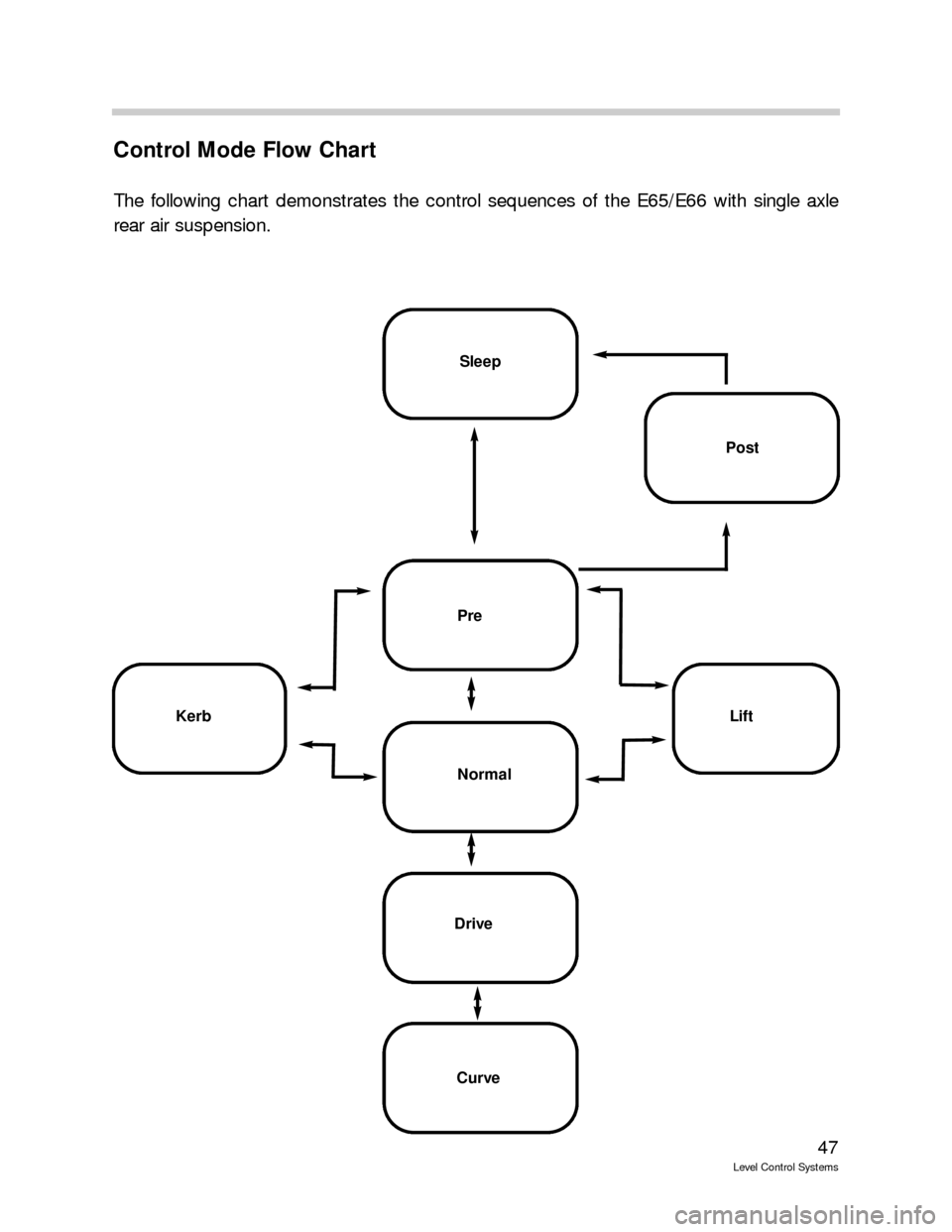
47
Level Control Systems
Control Mode Flow Chart
The following chart demonstrates the control sequences of the E65/E66 with single axle
rear air suspension.
Sleep
Post
Curve
Lift
Drive
Normal
Pre
Kerb
Page 49 of 57
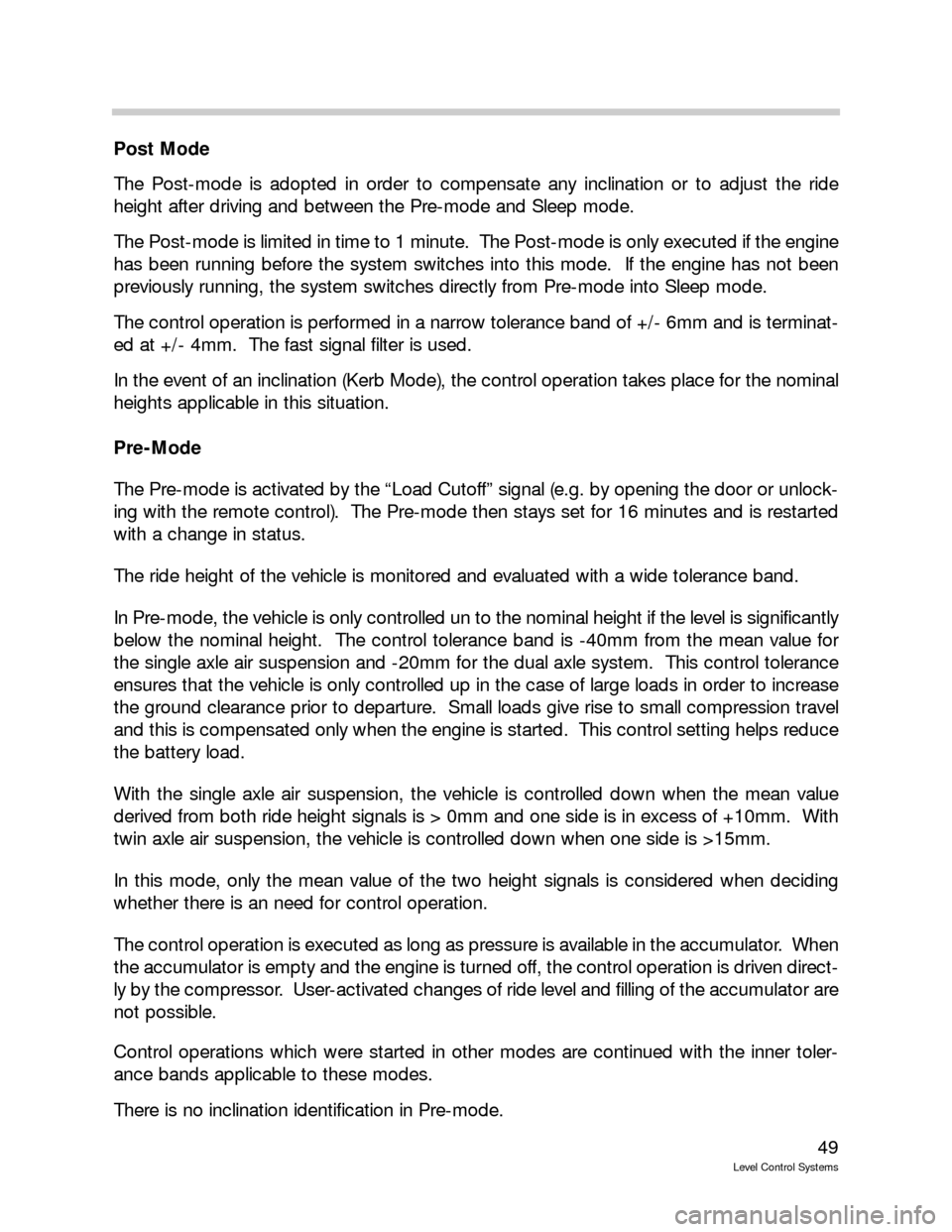
49
Level Control Systems
Post Mode
The Post-mode is adopted in order to compensate any inclination or to adjust the ride
height after driving and between the Pre-mode and Sleep mode.
The Post-mode is limited in time to 1 minute. The Post-mode is only executed if the engine
has been running before the system switches into this mode. If the engine has not been
previously running, the system switches directly from Pre-mode into Sleep mode.
The control operation is performed in a narrow tolerance band of +/- 6mm and is terminat-
ed at +/- 4mm. The fast signal filter is used.
In the event of an inclination (Kerb Mode), the control operation takes place for the nominal
heights applicable in this situation.
Pre-Mode
The Pre-mode is activated by the “Load Cutoff” signal (e.g. by opening the door or unlock-
ing with the remote control). The Pre-mode then stays set for 16 minutes and is restarted
with a change in status.
The ride height of the vehicle is monitored and evaluated with a wide tolerance band.
In Pre-mode, the vehicle is only controlled un to the nominal height if the level is significantly
below the nominal height. The control tolerance band is -40mm from the mean value for
the single axle air suspension and -20mm for the dual axle system. This control tolerance
ensures that the vehicle is only controlled up in the case of large loads in order to increase
the ground clearance prior to departure. Small loads give rise to small compression travel
and this is compensated only when the engine is started. This control setting helps reduce
the battery load.
With the single axle air suspension, the vehicle is controlled down when the mean value
derived from both ride height signals is > 0mm and one side is in excess of +10mm. With
twin axle air suspension, the vehicle is controlled down when one side is >15mm.
In this mode, only the mean value of the two height signals is considered when deciding
whether there is an need for control operation.
The control operation is executed as long as pressure is available in the accumulator. When
the accumulator is empty and the engine is turned off, the control operation is driven direct-
ly by the compressor. User-activated changes of ride level and filling of the accumulator are
not possible.
Control operations which were started in other modes are continued with the inner toler-
ance bands applicable to these modes.
There is no inclination identification in Pre-mode.
Page 50 of 57
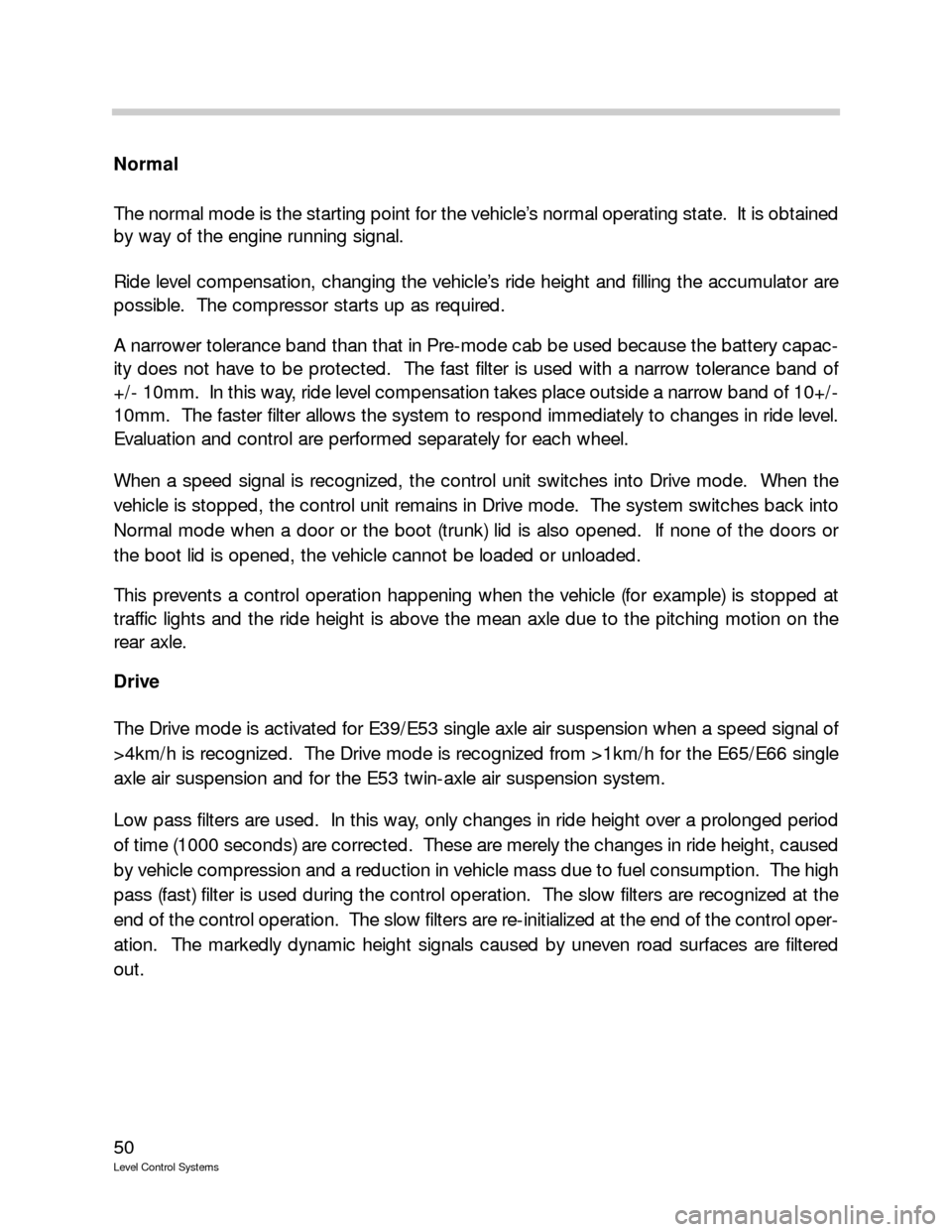
50
Level Control Systems
Normal
The normal mode is the starting point for the vehicle’s normal operating state. It is obtained
by way of the engine running signal.
Ride level compensation, changing the vehicle’s ride height and filling the accumulator are
possible. The compressor starts up as required.
A narrower tolerance band than that in Pre-mode cab be used because the battery capac-
ity does not have to be protected. The fast filter is used with a narrow tolerance band of
+/- 10mm. In this way, ride level compensation takes place outside a narrow band of 10+/-
10mm. The faster filter allows the system to respond immediately to changes in ride level.
Evaluation and control are performed separately for each wheel.
When a speed signal is recognized, the control unit switches into Drive mode. When the
vehicle is stopped, the control unit remains in Drive mode. The system switches back into
Normal mode when a door or the boot (trunk) lid is also opened. If none of the doors or
the boot lid is opened, the vehicle cannot be loaded or unloaded.
This prevents a control operation happening when the vehicle (for example) is stopped at
traffic lights and the ride height is above the mean axle due to the pitching motion on the
rear axle.
Drive
The Drive mode is activated for E39/E53 single axle air suspension when a speed signal of
>4km/h is recognized. The Drive mode is recognized from >1km/h for the E65/E66 single
axle air suspension and for the E53 twin-axle air suspension system.
Low pass filters are used. In this way, only changes in ride height over a prolonged period
of time (1000 seconds) are corrected. These are merely the changes in ride height, caused
by vehicle compression and a reduction in vehicle mass due to fuel consumption. The high
pass (fast) filter is used during the control operation. The slow filters are recognized at the
end of the control operation. The slow filters are re-initialized at the end of the control oper-
ation. The markedly dynamic height signals caused by uneven road surfaces are filtered
out.